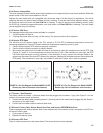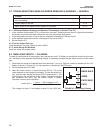
66
MODEL FCL-1056 SECTION 9.0
TROUBLESHOOTING
9.5.6 Sensor does not respond to changes in chlorine level.
1. Is the grab sample test accurate? Is the grab sample representative of the sample flowing to the sensor?
2. Is sample flowing past the sensor? Be sure the liquid level in the constant head sampler is level with the central
overflow tube and that excess sample is flowing down the tube. If necessary, disassemble and clean the over
flow sampler. See Section 8.4.
3. Is the pH compensation correct? If the analyzer is using manual pH correction, verify that the pH value in the
analyzer equals the actual pH to within ±0.1 pH. If the analyzer is using automatic pH correction, check the
calibration of the pH sensor.
4. Is the membrane clean? Clean the membrane and replace it if necessary. Check that the holes at the base of
the cathode stem are open. Use a straightened paper clip to clear blockages. See step 4 in Section 9.5.2.
Replace the electrolyte solution.
5. Replace the sensor.
9.5.7 Chlorine readings spike following sudden changes in pH (automatic pH correction).
Changes in pH alter the relative amounts of hypochlorous acid (HOCl) and hypochlorite ion (OCl
-
) in the sample.
Because the sensor responds only to HOCl, an increase in pH causes the sensor current (and the apparent
chlorine level) to drop even though the actual free chlorine concentration remained constant. To correct for the
pH effect, the analyzer automatically applies a correction. Generally, the pH sensor responds faster than the
chlorine sensor. After a sudden pH change, the analyzer will temporarily over-compensate and gradually
return to the correct value. The time constant for return to normal is about 5 minutes.
9.5.8 Chlorine readings are too low.
1. Was the sample tested as soon as it was taken? Chlorine solutions are unstable. Test the sample immediately
after collecting it. Avoid exposing the sample to sunlight.
2. Low readings can be caused by zeroing the sensor before the residual current has reached a stable minimum
value. Residual current is the current the sensor generates even when no chlorine is in the sample. It is also
called the zero current. Because the residual current is subtracted from subsequent measured currents, zeroing
before the current is a minimum can lead to low results.
Example: The true residual current for a free chlorine sensor is 4 nA, and the sensitivity is 350 nA/ppm.
Assume the measured current is 200 nA. The true concentration is (200-4)/350 or 0.56 ppm. If the sensor was
zeroed prematurely when the current was 10 nA, the measured concentration will be (200-10)/350 or 0.54
ppm. The error is 3.6%. Now, suppose the measured current is 400 nA. The true concentration is 1.13 ppm,
and the measured concentration is 1.11 ppm. The error is 1.8%. However, the absolute difference between the
reading remains the same, 0.02 ppm.
3. Sensor response depends on flow. If the flow is too low, readings will be low and flow sensitive. Verify that the
chlorine sensor is installed in the correct flow cell. See Figures 2-1 and 2-2. Verify that the liquid level in the
constant head sampler is level with the central overflow tube and that excess sample is flowing down the
tube. If necessary, disassemble and clean the overflow sampler. See Section 8.4.


















